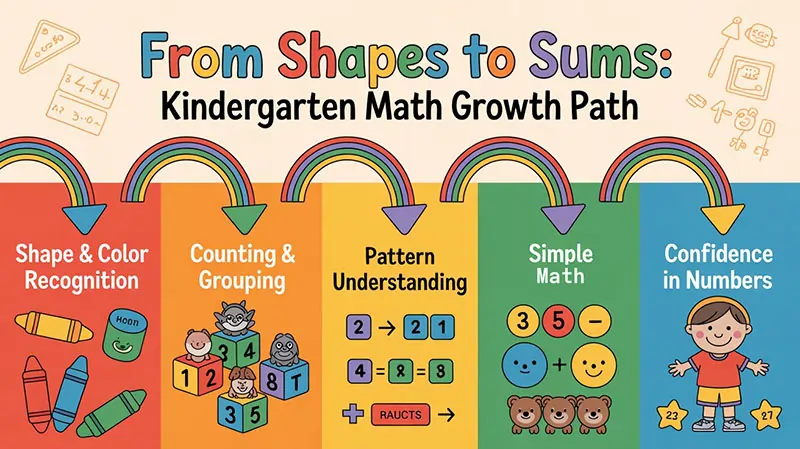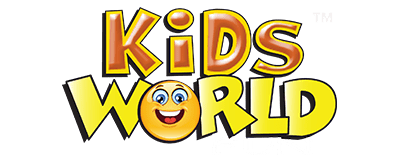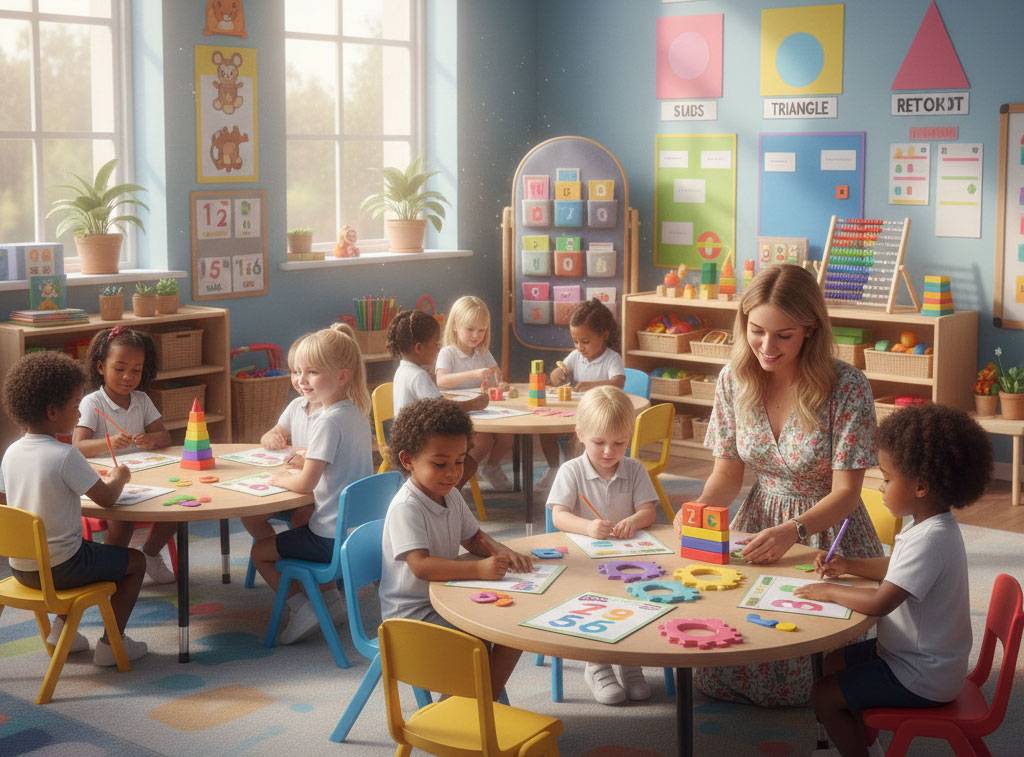Learning Numbers and Shapes: Kindergarten Math Worksheets and Games
For a child of five years old, mathematics may appear to be scary. You are left with patterns, shapes, and the ability to solve everyday problems when you remove the large word from the equation. When it comes to mathematics, kindergarten is not about learning formulae; rather, it is about discovering the world through numbers and shapes.
When a child counts the number of apples in a basket or notes that pizza slices resemble triangles, they are engaging in mathematical activities. They do not refer to it in such manner. Simply monitoring their surroundings and forming connections is all they are doing.
The transformation of learning into play is accomplished by parents and instructors through the utilization of kindergarten math worksheets, hands-on games, and visual exercises. Children develop self-assurance, curiosity, and a true joy for learning that lasts a lifetime when they experience mathematics as if it were a game rather than a chore.
1. A Brief Introduction to the Math Concepts Covered in Kindergarten
Building blocks of numeracy and spatial awareness are the primary themes of mathematics instruction in kindergarten. The objective is not total perfection; rather, it is recognition, comprehension, and engagement.
Kids between the ages of four and six learn via discovery. Natural in their inquisitiveness, they are always observing, categorizing, and organizing all that is going on around them. The underlying understanding of numbers and patterns can be developed through the use of stories, games, songs, and colorful worksheets throughout the introduction of mathematics. This approach does not feel like school.
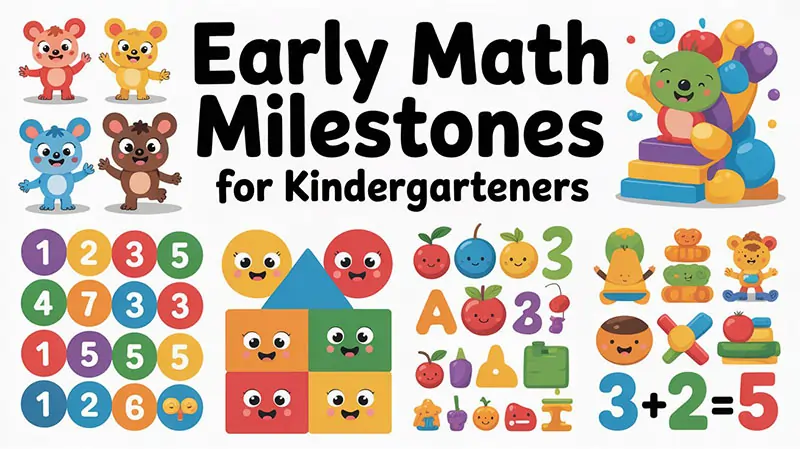
2. Overview of Numbers, Shapes, and Patterns in Number Analysis
Numbers
Numbers are the Counting bridges the gap between quantity and symbols. Those in kindergarten ought to be able to say:
- Be able to spell and recognize the digits 1–20
- Count each individual item in turn
- Recognize the difference between “more” and “less”
- Regroup the things (2 apples plus 3 apples equals 5 apples)
Listen to a child of five years old count toys. They move on to the next one after touching each one and reciting the number out loud. This physical connection—touching while counting—is what gives concrete form to numbers that are otherwise abstract.
Shapes
Geometry is presented in its most basic form through shapes. The following are some examples of shapes that children learn to recognize, trace, and compare:
- Two Dimensional Shapes: Circle, square, triangle, rectangle, oval, and hexagon are examples of two-dimensional shapes.
- Three-dimensional shapes: cube, sphere, cone, and cylinder
What’s the most exciting part? These forms are already familiar to children since they come from their world. Only that they are not yet familiar with the elaborate names.
Patterns
Patterns are a teaching tool for logic and accuracy. The ability to recognize sequences, such as red-blue-red-blue or circle-square-circle-square, assists in the development of cognitive reasoning and attention.

| Shape | Real-World Object | Example Activity |
| Circle | Clock, Coin | Trace and color circles |
| Square | Window, Box | Build square towers with blocks |
| Triangle | Pizza slice, Signboard | Match triangles in flashcards |
| Rectangle | Door, Book | Draw and count rectangles |
| Oval | Balloon, Egg | Identify ovals in pictures |
| Hexagon | Honeycomb | Color hexagonal patterns |
3. Interactive Counting and Grouping Exercise
Activities that involve movement, counting, and exploration are wonderful for children. Through the use of these interactive games, they are kept engaged while learning is taking place covertly.
The practice of counting around the room
Provide children with a “counting card” that asks them to locate three books, five pencils, and two chairs. This establishes a connection between mathematics and the real world, rather than relying on abstract worksheet numbers.
The Sorting of Objects
Make available a variety of toys, buttons, and blocks in a range of colors and sizes. The children should be grouped according to color, shape, or number. The development of skills in categorizing doesn’t require anyone to even mention the word “categorization.”
Hopscotch Math
Hopscotch grids with the numbers 1–10 should be drawn. You should ask the children to skip counting by twos, jump to even numbers, or leap to odd numbers. Engaging in math and physical activities together equals engagement.

4. Teaching mathematics through the use of visuals
The use of visual aids helps to concretize intangible ideas. Through the use of pictures, objects, and symbols, children are able to “see” mathematics.
Counting Charts
Visual memory is strengthened by posters that display numbers alongside images that correlate to them, such as five apples next to the number five. Significantly more effective than simply displaying the number by itself.
Posters of Shapes
Recognizability and vocabulary are simultaneously strengthened through the use of colorful charts that display geometric figures together with their names.
The use of pattern boards
ABAB or ABC sequences can be formed with the help of beads, stickers, and colored paper. In an instant, children are no longer merely pattern followers but rather pattern designers since they construct and extend their own patterns.

5. Exercises in Addition and Subtraction That Are Easy to Understand
As soon as children are able to count and group without difficulty, they are prepared to move on to basic addition and subtraction. Take your time with this stage. First and foremost is knowledge of counting.
Addition Through Visual Communication
Exhibit two different categories of stuff. Request information, “How many in all?”
For instance, the sum of 🐠🐠 and 🐠 equals three fish.
By doing so, the concept of combining quantities is developed prior to the introduction of plus signs and equals signs.
The process of subtracting through stories
When told through a story, subtraction becomes less abstract and significantly more entertaining.
As an illustration, “Five apples were dangling from the tree.” Two of them tumbled to the ground. How many are there that are still available?
Kids are able to picture the story. Math stops being numbers on paper and instead becomes scenarios that an individual may comprehend.
Number Bonds
Number bonds are a visual representation of the way numbers can be broken down into their component parts.
Use the following example: 5 = 2 + 3 or 4 + 1. Children are prepared for algebraic thinking in the future without having to use intimidating math jargon currently.
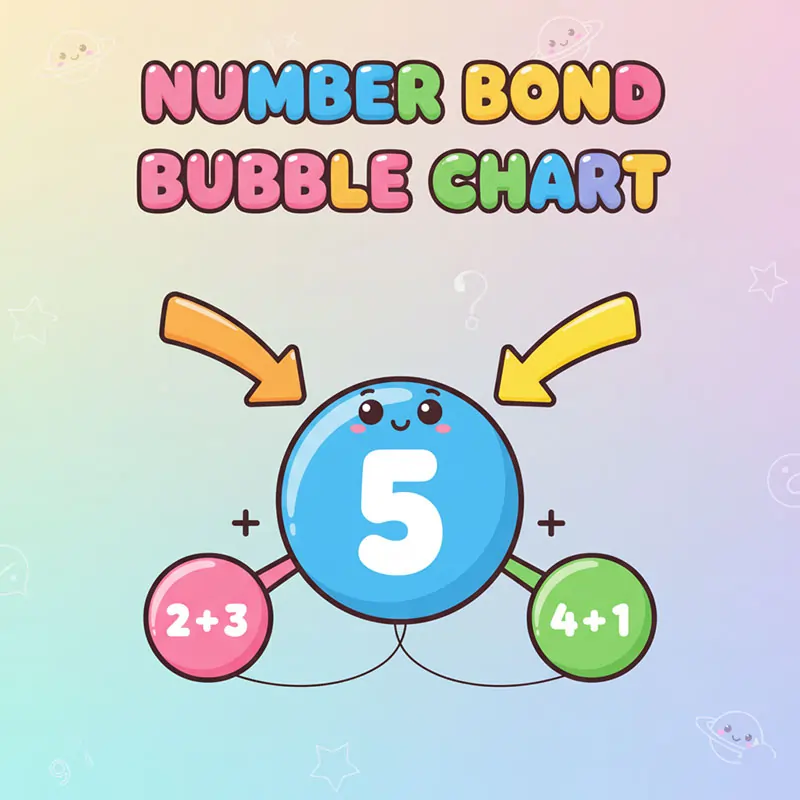
| Equation | Visual | Answer |
| 2 + 1 = ? | 🍎🍎 + 🍎 | 3 |
| 5 – 2 = ? | 🐻🐻🐻🐻🐻 – 🐻🐻 | 3 |
| 3 + 2 = ? | 🧸🧸🧸 + 🧸🧸 | 5 |
| 4 – 1 = ? | 🐠🐠🐠🐠 – 🐠 | 3 |
6. Learning Through Play and Storytelling
Learning is most effective for children when it is akin to play. Math may be made more interesting and less daunting via the use of games and stories.
Math for Storytime
Books that include numbers and shapes should be read for:
- “Ten Little Ladybugs” is a great book for counting;
- “Mouse Shapes” is a great book for geometry;
- “The Very Hungry Caterpillar” is a good book for sequencing and numbers.
When compared to separate arithmetic lessons, math that is interwoven in stories is more memorable.
A combination of board games and digital games
Playing straightforward board games such as “Chutes and Ladders” or “Snakes and Numbers” instills a natural sense of numerical sequence recognition in children.
Kids can have fun playing math games online, such as:
- “ABCya’s Counting Fish,”
- “CoolMath4Kids Pattern Play,” and
- “PBS Kids Math Racer”
are some of the games that students can play.
Learning should be combined with enjoyment and interaction. Screen time that serves a purpose.
Outdoor Math
Place chalk on the ground and create shapes with it. Request that the children hop onto the circles or triangles. The fact that it incorporates motor skills and shape recognition while simultaneously burning energy is a benefit that parents enjoy.
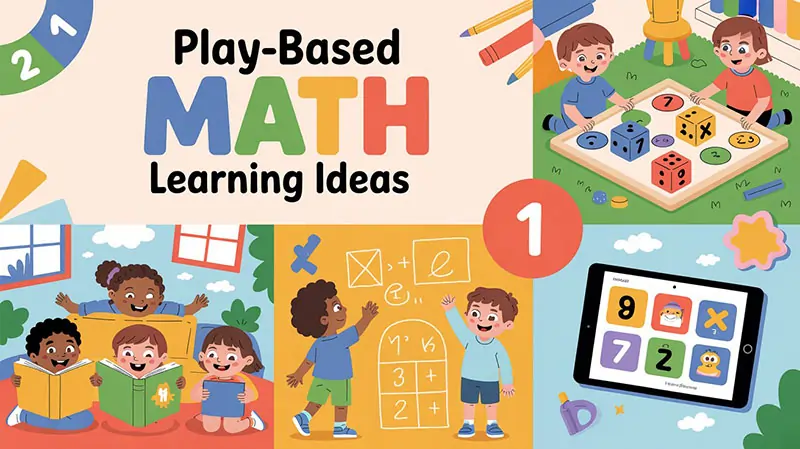
7. Worksheet Practice Ideas
The concepts that are learnt through play and narrative are reinforced with worksheets. The key? Incorporate elements that are vibrant, interactive, and gratifying.
Counting Worksheets
Counting objects, such as stars, animals, and toys, and writing the numbers that correspond to those counts. Repetition that is straightforward but powerful.
Shape Tracing Worksheets
By tracing and coloring a variety of shapes, children are able to strengthen their fine motor skills while simultaneously understanding geometric concepts. One activity, two different talents.
Worksheets for Pattern Work
Provide sequences such as 🍜🍌🍎🍌 and inquire for the subsequent sequence. Pattern recognition is the process by which prediction skills are developed.
Addition and Subtraction Worksheets
Make use of photo questions such as “3 cats plus 2 cats equals?” Visual learners require those images in addition to the numerical values.
Activities Based on Colors and Numbers
Create some imaginative works of art by assigning colors to numbers. “Color 1 is red, color 2 is blue, and color 3 is yellow.”
Children believe that they are creating beautiful pictures. These individuals are, in fact, engaging in repetitive practice of number recognition.
8. Frequently Asked Questions Regarding Kindergarten Mathematics
Q1: At what age should children begin learning about numbers and shapes?
Between the ages of two and three, the majority of children are able to recognize numbers and shapes. Basic addition, subtraction, and pattern identification are best taught to children between the ages of four and six in kindergarten. Before that point in time? Play should take precedence over academics.
Q2: What is the recommended length of time for kindergarteners to spend on their arithmetic skills?
For the purpose of preserving concentration and avoiding weariness, sessions should be kept brief—15–20 minutes every day. Because of this age, quality is always superior to duration.
Q3: what are the most effective instruments for teaching numbers and shapes?
Use activities such as flashcards, counting cubes, storybooks, and arithmetic worksheets that can be printed out for kindergarten. It is important to have variety since different children react differently to different instruments.
Q4: Are youngsters able to play math games online that are both safe and effective?
Yes, if the item is selected with care. Make use of kid-friendly websites such as ABCmouse, PBS Kids, and Starfall, which are centered on educational objectives and come equipped with built-in controls for screen time exposure.
Q5: What are some ways that parents can assist their children at home?
Mathematics should be incorporated into daily tasks; for example, counting fruits, measuring materials, and identifying shapes while walking. When math is omnipresent, it becomes commonplace rather than frightening
9. Concluding Remarks and a Math Pack For Printable Use
Math is present in everything that children interact with, including the toys they play with, the food they consume, and the stories they hear. Through the medium of games, colors, imagination, numbers, and forms are transformed into enjoyable companions rather than formidable adversaries. Not only do children improve their mathematical abilities via the use of kindergarten math worksheets, interactive counting games, and pattern-based exercises, but they also develop their self-assurance and their natural enthusiasm in learning.
Playful repetition, which consists of worksheets that reinforce what is taught through movement and speech, should be taken into consideration by both parents and instructors. The use of both hands-on practice and visual assistance guarantees that children are able to acquire mathematical concepts in a way that is both enjoyable and memorable.
Avoid worrying about achieving perfection. Anxiety regarding the engagement. One who is able to count accurately but despises the activity is not as likely to have a good foundation in mathematics as a kindergartener who enjoys counting.
